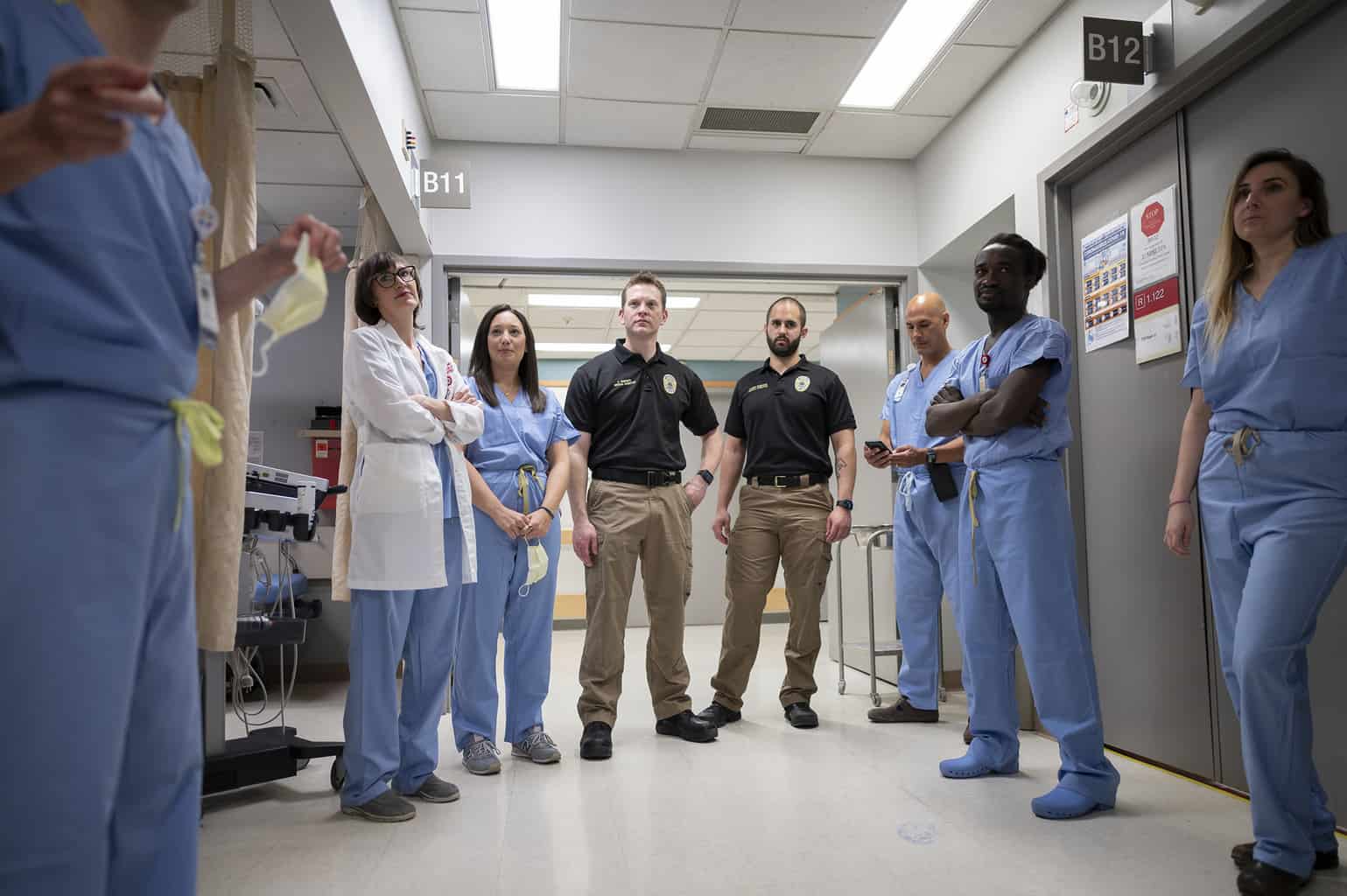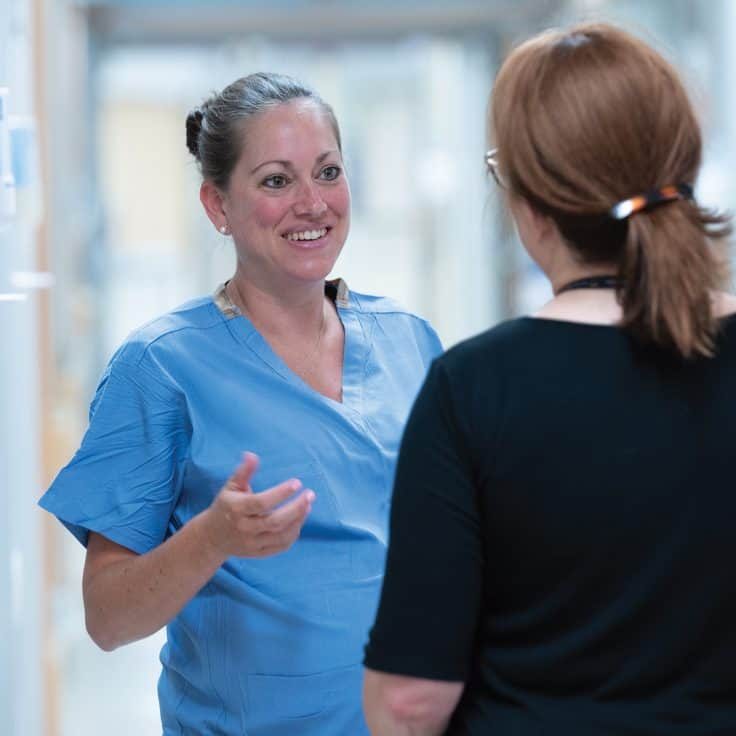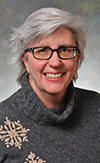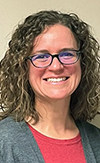
Emergency Medicine/Internal Medicine Residency
Five-Year Residency
5-year residency leading to board certification in both specialties
Single site location at a Level 1 Trauma Center
Outstanding clinical training
Specialized tracks in Global Health, Ultrasound, Education, Quality, and Observation Medicine
Program Overview
Innovative, Single-Site Training for Emergency and Internal Medicine
The five-year Emergency Medicine/Internal Medicine Residency at Hennepin Healthcare offers residents clinical training in emergency and internal medicine with a diverse patient population, all in a comprehensive academic healthcare system in downtown Minneapolis.
Launched in 2006, our innovative single-site program is one of only 11 combined EM/IM residencies in the country. It leverages our ACGME-recognized Internal Medicine Residency and our pioneering Emergency Medicine Residency into a single curriculum.
Our structured approach enables EM/IM residents to maximize their education in each department. Residents attend an orientation month followed by three-month immersions in each discipline. EM/IM residents enjoy significant leadership responsibilities in both programs, including serving as Chief Residents in the final year.
About Our Curriculum
Our curriculum emphasizes hands-on learning with the latest procedures and technology, including training in our Interdisciplinary Simulation and Education Center.
Most rotations are based at Hennepin Healthcare, with select rotations at the University of Minnesota Children’s Hospital, Children’s Hospital of Minneapolis, Methodist Hospital, and North Memorial Medical Center. Residents receive the benefits of a strong community at our primary site while facilitating experiences in the full range of emergency medicine and internal practice at academic and community sites.
As an academic healthcare system, we also offer significant support for clinical research. Hennepin Healthcare maintains its own research foundation. Research projects by residents are well supported. Residents regularly present research at local and national events. EM/IM residents also facilitate a joint conference between Hennepin Healthcare’s Departments of Emergency Medicine and Internal Medicine several times each year.
Emergency Medicine / Internal Medicine / Critical Care
Hennepin Healthcare offers a combined residency program in Emergency Medicine / Internal Medicine / Critical Care Medicine. In this 6-year program, residents complete the requirements for training in both EM and IM, as well as a residency in critical care medicine. Residents graduating from this program will have outstanding skills in resuscitation, airway management, bedside ultrasound, ventilator management, advanced hemodynamic monitoring, and resuscitative procedures.
Residents may apply to enter this pathway at the beginning of their PGY-4 year, after completing 3 years of an EM/IM residency program. Graduating medical students do not match directly into this program.
About Our Faculty
Academic Leaders in All Subspecialties
Our residents train with nearly 150 full-time faculty in the combined Emergency Medicine/Internal Medicine Residency, including professionals in all subspecialties of Internal Medicine.
Our physicians are academic leaders, outstanding clinicians, and research professionals. Most hold faculty positions at the University of Minnesota Medical School in addition to their leadership and teaching roles at Hennepin Healthcare and beyond. All are dedicated to helping train some of the best medical professionals in the country.
EM/IM and EM/IM/CC Program Director
Thank you for taking the time to learn about our program. It is a tremendous honor to direct the EM/IM and EM/IM/CC residencies at Hennepin Healthcare. I completed the Hennepin Healthcare EM/IM residency and subsequently completed a fellowship in Medical Toxicology. In my current roles, I use my combined training both in my practice and as an educator working to create the best possible educational environment for our residents. I value the breadth of my practice as faculty in our Emergency Department, and as a toxicologist caring for patients on the hospital wards and via telephone consultations at the Minnesota Poison Control System. Our combined residents are curious, motivated, and service-oriented. They are leaders and role models for whom it is my honor to provide guidance as they train to become truly outstanding physicians who move on to amazing things as graduates of our program.
Travis D. Olives, MD MPH MEd
Program Director, EM/IM and EM/IM/CC Residency programs
Email: [email protected]
Phone: 612-873-3511
Categorical Program Leadership
- Dr. Rosemary Quirk, Program Director, Internal Medicine Residency and Associate Professor at the University of Minnesota
- Dr. Danielle Hart, Program Director, Emergency Medicine Residency and Associate Professor at the University of Minnesota
EM/IM Resident Rotations
Our residents take an active role in shaping the structure of our residency and facilitating changes needed to optimize the experience for incoming residents. While rotations are actively managed to improve resident experiences, the core structure of our residency follows.
PGY-1
PGY-1 residents undergo orientation in the first month of combined training including a mix of EM shifts, ambulatory IM experience, and Continuity Clinic. This enables PGY-1 residents to familiarize themselves with both departments and get to know senior residents and faculty in both programs.
A more relaxed orientation schedule in both departments takes place at IM’s morning report, noon conferences, and EM stabilization conference on Thursdays, allowing residents to meet colleagues in both disciplines.
During the rest of the PGY-1 year, EM/IM residents join their colleagues as interns on inpatient medicine service, including General Medicine, Cardiology, Renal, MICU, and off-service EM rotations, including Pediatrics, Trauma Surgery, and OB/GYN.
PGY-1 residents serve as primary medical providers in the Emergency Department, supervised by PGY-3 residents and faculty.
PGY-1 Rotations
- Orientation
- Emergency Medicine (3 blocks)
- Pediatric EM
- Surgery
- Medical ICU
- Geriatrics
- Renal Medicine
- Inpatient Medicine (2 blocks)
- Toxicology / Ultrasound
PGY-2
The PGY-2 year offers additional responsibility in both programs.
In IM, combined residents serve as senior residents and manage inpatient teams, including supervising interns and medical students. There is no "resi-tern" or PGY-1.5 in our program; EM/IM combined residents progress in responsibility along with their categorical peers.
In EM, PGY-2 residents gain added responsibility for solo overnight shifts in the Emergency Department, with the opportunity to master ultrasound techniques and perform critical procedures in the stabilization room. EM/IM residents spend off-service PGY-2 rotations as senior residents, managing the Trauma Surgery team, and experience with Toxicology, EMS (including ambulance and helicopter ride-alongs), and specialty clinics for oral surgery, dermatology, colorectal, and radiology.
PGY-2 Rotations
- Rheumatology
- Endocrinology
- Infectious Diseases
- Medical ICU
- Inpatient Medicine (2 blocks)
- Emergency Medicine (4 blocks)
- Surgery
- Hyperbaric Medicine / Neonatal ICU
- Elective
PGY-3
During this challenging year, EM/IM residents transition to their new role as Emergency Department "pit boss." PGY-3 residents first complete two months of Neurosurgery training, focused on managing patients with critical head injuries in the SICU. Faculty also train PGY-3 residents in small group didactics for the acute management of critical illnesses, such as airway adjuncts, thoracotomy, and toxicology.
IM rotations include several subspecialty consult services such as Nephrology, Pulmonary, ID, and GI. The program includes six Selective months where residents can explore specialties in-depth, undertake a clinical research project, explore our Pathways programs in Global Health or Primary Care, or improve procedural proficiency.
PGY-3 Rotations
- HCMC Emergency Medicine (4 blocks)
- Neurosurgery
- North Memorial Emergency Medicine
- Pulmonary
- Medical ICU
- Renal Medicine
- Nephrology consults
- Inpatient Medicine
- Elective
PGY-4
IM rotations cover a mix of inpatient (MICU and general medical wards) and consults. These programs focus on supervised autonomy in clinical decision-making, as well as improving formal and informal teaching skills. Two additional electives provide an opportunity for independent learning.
EM curriculum features continued leadership experience in the Emergency Department, including managing stabilization room cases. EM/IM residents gain a second month of dedicated Pediatrics training, which is unique to the combined program.
PGY-4 Rotations
- Emergency Medicine (4 blocks)
- Pediatric Emergency Medicine
- Inpatient Medicine
- Medical ICU
- Neurology / Psychiatry
- Gastroenterology
- Hematology / Oncology
- Elective (2 blocks)
PGY-5
Clinical responsibilities include 5-6 months as EM "pit bosses," and a fifth month in the MICU on night float. PGY-5 residents may also rotate as hospitalists or intensivists at Methodist Hospital, a private, community hospital located just minutes from downtown in St. Louis Park. The PGY-5 year includes two selectives, scheduled back-to-back to facilitate an experience abroad or extended time for an academic project.
PGY-5 Rotations
- Emergency Medicine (5 blocks)
- Pediatric Emergency Medicine
- Medical ICU
- Inpatient Medicine
- Cardiology consults
- Quality Improvement / Patient Safety
- Surgical / Medical ICU
- Elective (2 blocks)
What Sets Us Apart?
Collegial learning environment
Our single-site program and academic culture promote collaboration and teamwork at all levels. Residents work side-by-side with fellows, faculty, and specialists from numerous disciplines, including more than 100 medical students who rotate at HCMC each month.
Hands-on clinical experience
Our residents take an early and active role in patient care and obtain decision-making roles quickly. Within the Emergency Department, EM/IM residents direct the initial stabilization of all critically ill patients, manage airway interventions, and oversee all critical care alongside their categorical emergency medicine colleagues.
Meaningful continuity clinic experience
EM/IM residents maintain their continuity clinic together on Thursday afternoons with a dedicated preceptor promoting an education that is tailored to the unique skills and abilities of EM/IM residents.
Integrated technology
HCMC features state-of-the-art medical equipment and a completely paperless environment, with Level 7 implementation of the Epic electronic health record. Residents learn and utilize state-of-the-art tools as part of their daily routine including extensive ultrasound access within the ED and ICUs. ED-initiated ECMO, and a regional poison Center site immediately beneath the ED.
Leadership opportunities
From supervising medical students and other residents to directing patient care as "pit boss" in the Emergency Department, EM/IM residents take on substantial leadership responsibility. PGY-5 residents become chief residents in both programs.
Diverse case mix
Few settings offer the range of patients and pathology available at HCMC. As the region’s safety net hospital and the state’s busiest emergency department, residents train in a high-volume setting and treat individuals of all cultural and economic backgrounds.
Applications due November 1
Requirements
Your application must include:
- Medical school transcripts
- Dean’s letter
- Minimum of two letters of recommendation, including at least one Standardized Letter of Evaluation (SLOE)
- USMLE Step 1
- Personal statement
Process
- Submission: Submit your application through the Electronic Resident Application System. We do not accept applications through the mail. HCMC participates in the National Resident Match Program (NRMP).
- Scoring: Each applicant will be scored based on these criteria:
- Board scores
- Research
- Medical school transcripts
- Leadership Roles
- Honors and accomplishments
- Dean’s letter
- Letters of recommendation
- Personal statement
We recognize the challenges that the COVID-19 pandemic has placed on this aspect of applications. For our purposes, a minimum of one SLOE (Standardized Letter Of Evaluation) is preferred. We understand that O-SLOEs (Off-service Standardized Letters Of Evaluation) may necessarily fill this role in some circumstances.
- Interviews: Applicants who meet a pre-determined score threshold will be invited for interviews. We will notify you via email regarding interviews. We hold interviews on one Monday in November, December, and January.
Resources for Applicants to EM/IM Programs
CORD Dual Accreditation Applying Guide




